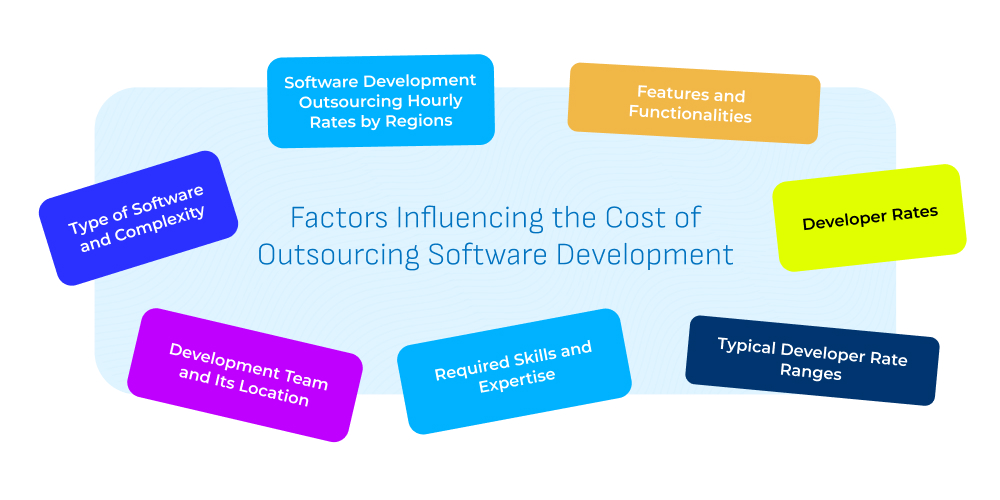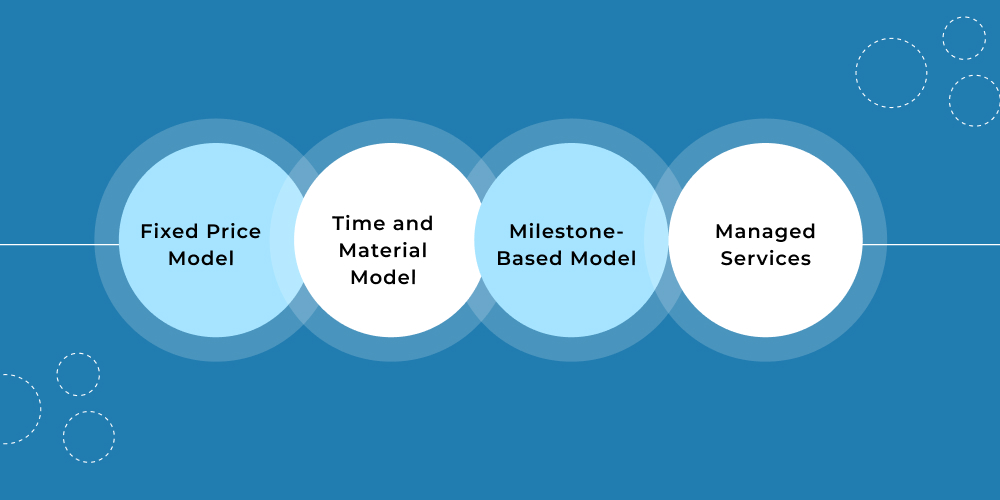How Much Does it Cost to Outsource Software Development
Ditstek Blogs
More and more companies, especially the ones using advanced software or applications, are outsourcing their software development projects to save time, effort and money. Planning to build a new software but confused whether you should get it done by your in-house team or outsource to a company. Well, you are not alone, many businesses get confused at this point.
However, there are many things you can consider making an informed decision, and cost is the most important. In some cases, getting the software development done by your in-house team is beneficial, while sometimes outsourcing offers you more benefits in terms of cost, expertise and talent.
In this blog, we will explain why businesses outsource software development, factors influencing the cost of outsourcing and how to choose the best engagement model for your project.
Why Outsourcing Software Development Is Beneficial
Outsourcing software development not only reduces costs but also gives businesses access to global talent, faster delivery, and greater flexibility. By working with external teams, businesses can tap into specialized skills that may not exist in-house, whether it's expertise in AI, mobile development, or emerging tech stacks. Outsourcing also helps speed up time to market, especially when internal teams are overloaded or when rapid scaling is required.
Your Next Big Idea Deserves Better Than Freelancers!
DITS turns your software development dreams into fully functioning platforms. We bring the team, the tech, expertise and the tenacity.
So, What Does It Really Cost to Outsource Software Development?
The short answer? It depends on what you're building, who you're hiring, and where they’re located. But let’s break it down with some realistic numbers. For a simple software project, such as a basic internal dashboard, a standalone web tool, or an MVP with limited functionality, costs typically start around $10,000 and can go up to $30,000. Mid-sized projects, like a custom content management system, a product catalog with an admin panel, or a SaaS platform with standard user roles and integrations, usually range from $30,000 to $100,000. For enterprise-level solutions with complex architecture, API ecosystems, AI-powered features, and real-time data processing, costs can easily exceed $100,000 and reach $500,000 or more, depending on scale and sophistication.
Another key factor is where your outsourcing team is located. For example, developers in regions like India, Southeast Asia, or Eastern Europe generally charge between $20 to $60 per hour. Teams in Latin America may range from $30 to $80 per hour, while those in North America or Western Europe often start at $80 and can go well beyond $200 per hour. That means the same project could cost $25,000 in one country and $100,000+ in another, purely based on geography.
Costs also rise with team composition. Hiring just one developer will naturally be cheaper than engaging a full-service team that includes a project manager, UI/UX designer, QA engineers, and DevOps support but the latter often ensures smoother delivery and long-term success. And don’t forget post-launch expenses: ongoing maintenance, updates, and support typically require 15–20% of your initial development cost annually.
Factors Influencing the Cost of Outsourcing Software Development
Calculating the exact cost of outsourcing software development projects to an overseas team is challenging, as it depends on a variety of factors. Here are the factors which influence the cost of outsourcing software development.

Type of Software and Complexity
Software can range from a simple internal tool to a full-scale enterprise platform. The type of software you're building whether it's a web app, mobile app, desktop software, SaaS platform, or a cross-platform solution has a direct impact on the cost. Complexity adds another layer. A basic solution with limited features will naturally cost less than a complex system involving multiple user roles, integrations, advanced security, and real-time data processing. To estimate the cost accurately, it's important to define what type of software you’re developing and how complex the functionality needs to be.
| Complexity | Estimated Cost | Examples |
| Low | $50,000 to $80,000 | Internal admin dashboards, simple content management systems (CMS), basic inventory tools, standalone calculators, employee time-tracking systems |
| Moderate | $90,000 to $120,000 | E-commerce platforms, product/order management systems, customer portals, business reporting dashboards, booking systems |
| High | $120,000 to $150,000 or more | CRM or ERP systems, social networking platforms, advanced analytics & BI tools, real-time collaboration software, software requiring API integration or machine learning features |
Development Team and Its Location
The software development team structure is also crucial in determining the cost of software development. Building software is not a one-man task, but involves professionals from different domains. For, example, you need business analysts, project managers, programmers, designers and QA testers in a team to work on your project.
Also, the location of the development team significantly impacts the cost of the project. Locations like the United States, and Western Europe have quite expensive teams, while India, Eastern Europe and Southeast Asia have the most affordable software development companies. If you are ready to spend high, you should think of outsourcing your project to locations like the United States, but if you want to keep the costs low, you need to outsource to a team in Eastern Europe or South East Asia.
Software Development Outsourcing Hourly Rates by Regions
Let's explore how much development teams from different regions charge for their services.
| Country or Location | What to Know | Hourly Price of Software Developers |
| North America (USA and Canada) | When it comes to software development, Canada and the United States are considered the most expensive. Startups usually hire developers from these locations to minimize costs while maintaining the quality of the application. In contrast, enterprises search for talent and expertise in specific programming languages and AI to achieve their desired results. | $100 – $250 |
| Eastern and Central Europe (Ukraine, Romania, Poland) | Eastern and Central Europe have evolved as the largest tech hubs in software technology. Companies prefer outsourcing their projects to these locations including Ukraine, Romania, and Poland as they offer value for money services. | $50 to $70 |
| Western and Northern Europe (Austria, Belgium, Germany, France, Denmark, Finland) | Western and Northern Europe covers many countries with high quality software development teams. These locations have different and unique outsourcing opportunities. Therefore, it's best to examine different areas before outsourcing your project. The development costs in Western and Northern Europe are higher as compared to the Eastern part. The hourly prices in some locations could achieve the prices in the United States. |
$60 to $100 |
| East and South Asia (India, China, Japan, Bangladesh, Sri Lanka) | Asia has the most debatable locations for outsourcing due to highly competitive pricing in countries. It has the most affordable software development teams in the world, preferably in India, Vietnam and Philippines. In addition, you can find developers with the most reasonable hourly pricing in East and South Asia. However, the hourly prices also vary with the key features, functionality and complexity of the application. | $25 to $50 |
Required Skills and Expertise
Expertise encompasses an outsourcing team's collective skills, knowledge, and experience. This includes:
- Programming languages (e.g., Python, Java, C#)
- Proficiency with industry-specific software (e.g., Cerner for healthcare, Bloomberg Terminal for finance)
- Years of experience
- Understanding of various legislative regulations
- Industry knowledge (e.g., customer expectations, typical business processes)
- Specialized knowledge (e.g., blockchain, artificial intelligence, machine learning)
- Certifications and qualifications (e.g., AWS, ISO certifications)
The required level of expertise directly influences a software developer's hourly rate and the overall outsourcing cost. It also significantly impacts the efficiency and speed of development.
Features and Functionalities
The features and functionalities that you will put in your custom software development will be the most important part of its architecture. Features that are more advanced, will take more time to develop and therefore cost more money when using outsourced developers. Functions that require more complexity, such as being adjusted for multiple platforms and data synchronizations, will take even longer and be more costly.
Developer Rates
Developer rates are a major cost factor in software outsourcing. While many companies offer fixed pricing, hourly rates typically vary depending on the project’s complexity, the developer’s experience and skills, and their location. However, a higher rate doesn’t always mean better quality. A skilled developer writes clean, efficient code and delivers value faster, whereas a less experienced developer might spend more time but produce lower-quality results, meaning you pay more without getting proportional value. Ultimately, quality matters more than how many hours a developer logs.
Typical Developer Rate Ranges
You will commonly see two main pricing models: hourly costs and project costs. Understanding these models is useful to inform the software development team what you expect around your budget.
| Hourly Costs | Fixed Price/Project-Based Costs |
| In the hourly rate model, you pay upon completion of each hour (or fraction of an hour, for example, 15 minutes or 30 minutes) of work a developer, or development team, spends on your project. The hourly rate model is a very common model in software development, especially for projects where the requirements will evolve over time, and for ongoing maintenance and support. Your payment is essentially for the time and expertise of the development resources. | In a fixed-price or project-based model, you will agree to a single, fixed price for the entire software development project. The fixed price is established based on a detailed scope of work, clear requirements, and agreed-upon deliverables. You pay for the finished product, regardless of how much time it takes to build. |
Outsourcing Isn’t Just Cheaper - It’s Smarter!
DITS gives you access to top-tier talent without the full-time hiring drama. It’s cost-effective and commitment-light.
Best Engagement Model for Outsourcing Software Development
There are a variety of engagement models available for software development. However, the best engagement model for you depends on your specific requirements and priorities. There are fixed price models, time and material models, dedicated team and hybrid approaches, each of them has its strengths and weaknesses. So, it's best to have a careful assessment before selecting any model according to your requirements.

Fixed Price Model
The fixed price model is best for enterprises who have well-defined requirements for the software or application they want to develop. The scope of the project and its cost are agreed upon, usually at the time of signing the contract and everything is done in accordance to this contract. The project costs in the fixed price model are closely linked to the defined deliverables tied to several payment milestones during the course of a software development project. Fixed price model helps you to monitor the progress regularly and minimize any risks associated with the project.
Fixed price model is best for companies who have planned everything in detail for the product they want to develop with clear requirements and deadlines for the project.
Time and Material Model
Also abbreviated as T&M, this model is best for those projects where the requirements are not well-defined, and they continue to evolve with the course of the project. In this model, the development company agrees to offer resources for pre-determined skills and expertise. They also specify a billing rate for each type of resource.
T&M model is beneficial for projects
- Large scale projects with high complexity levels
- Continuous product evolution development
- Solution design
- Research and consulting assignments
- Support & Maintenance contracts
This model is suitable for projects where you need some time to define your requirements. After defining the scope of the project, you can switch to a fixed price model for development. One of the best benefits of this model is that it provides flexibility in teams of specifications that evolve with the changing markets, technology trends and business objectives.
Milestone-Based Model
This model is ideal for organizations with process-oriented setups. It focuses on delivering specific milestones or Service Level Agreements (SLAs) within a project. For this model to succeed, milestones, roles, and responsibilities must be clearly defined and unambiguous for all parties involved.
Milestone based models are best for companies who want to work with new teams and make part payments at several stages of the project. They can check the quality of work and assignments completed during several milestones. The flexibility of the payment structure allows companies to make easy payments in parts rather than paying a lump sum amount.
Managed Services
Managed Services is a comprehensive engagement model where a development team holistically manages a service end-to-end for your organization. This includes handling all requirements within a specific area of work.
Typical tasks in Managed Services include:
- Staffing projects with the right personnel.
- Providing necessary tools and infrastructure.
- Implementing processes and best practices tailored to the project.
- Maintaining documentation.
- Producing project reports.
- Ensuring timely deployment of deliverables.
This model is particularly well-suited for organizations that want to concentrate their time and resources on core business functions. Instead of investing in areas where external, more experienced partners can provide expertise, organizations can outsource entire functions like software development, maintenance, or quality assurance to be managed by a chosen partner.
Looking to Cut Software Costs Without Compromising? It’s Possible!
With DITS, outsourcing isn’t a compromise. It’s a strategic move that saves cash and delivers quality.
Why Partner With DITS for Outsourcing Software Development
For the success of any project, it is essential to choose the right development team. A team that offers high quality services at affordable prices. DITS has an experienced software development team with years of experience and technical expertise in various programming languages and coding. In addition to coding, we have experienced and creative designers in our team, who will take your project to the next level. In addition, we use transparent communication, and a client-centric approach in every project we work on.
Our rigorous talent acquisition process allows for the sourcing of professionals that are highly skilled for your specific project needs. We ensure data security, and intellectual property protection in every project. DITS work on collaborative partnerships, with flexible engagement models and proactive problem-solving.
Conclusion
Outsourcing software development is a smart business strategy for companies looking to lower costs, tap into the global workforce, and speed up project timelines. Though the total cost of software can vary depending on many factors (complexity, feature requirements, team location, and level of expertise and performance), outsourcing can usually provide you meaningful value relative to in-house development.
Picking the appropriate engagement model (fixed price, time and material, managed services, etc.) is crucial to align your development goals with your business goals. Local or international, your success depends on careful planning and a trustworthy partner, outsourced development can be cheap and increase those costs, quality, and innovative power! At DITS, we partner with you to leverage our technical expertise, industry experience, and collaborative mindset to provide solutions specifically for you to keep up with the fast-paced, ever-changing digital world.
FAQ’s
1. Why do businesses outsource their software development?
Companies outsource software development to save money, access specialized skills, and complete projects faster. It also allows companies to concentrate their efforts on core business functions by leaving technology-related work to specialized outside resources.
2. How much does it cost to outsource a software development?
The cost of outsourcing can depend on the complexity of the project, the location of your team, the features your software needs, and your engagement model. On average, you can expect to pay between $25 and $250 an hour or between $50,000 and $150,000+.
3. What countries are the best for outsourcing software development?
India, Vietnam and the Philippines are the top countries for affordability. Many Eastern European countries provide a good balance of affordability and quality, such as Ukraine, Poland, and Romania. If you are in the USA, it is important to know that you will have to pay a premium for software development in the USA and Western European countries even though you are spending more money, you are also getting premium markets.
4. What is the best engagement model for my project?
This is a question with an answer that is contingent on your project scope. If you have well-defined requirements and scope for your project, you can use a fixed price engagement model. If you are not certain of scope, and you think it will change, you can use a time and material engagement model. If you want your project completely handled from start to finish, a managed service model would be the best engagement model for you.
5. Is outsourcing software development secure?
It can be secure with the right partner. Make sure your software development team is compliant with data protection laws and works with systems and processes to protect your intellectual property and sensitive business information through things like non-disclosure agreements and secure infrastructure.
6. Is it possible to change my outsourcing model in the middle of a project?
Yes, many companies will start with a time and materials model and change to a fixed cost model once the scope is defined. The ability to switch models has to do with your agreement in place and the outsource software development company's practices and policies.
7. How do I determine the right outsourcing partner?
Find technical know-how, a history of projects, the ability for transparency, and an ability to adjust engagement models as needed. You can read reviews and assess portfolios. You could select a small project as a way to find the right fit for your partner.

Dinesh Thakur
21+ years of IT software development experience in different domains like Business Automation, Healthcare, Retail, Workflow automation, Transportation and logistics, Compliance, Risk Mitigation, POS, etc. Hands-on experience in dealing with overseas clients and providing them with an apt solution to their business needs.
Recent Posts
Get in touch











 Calgary | Edmonton | Vancouver | Toronto
Calgary | Edmonton | Vancouver | Toronto